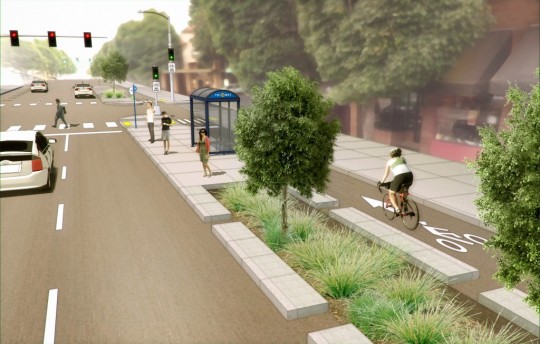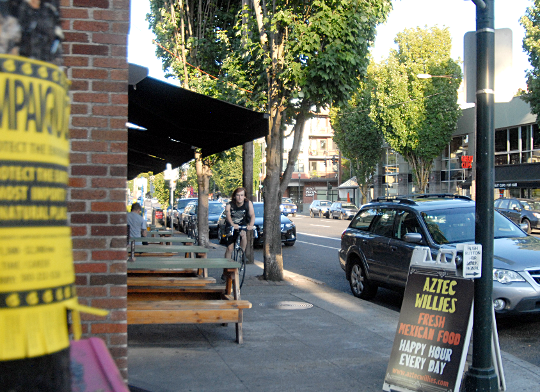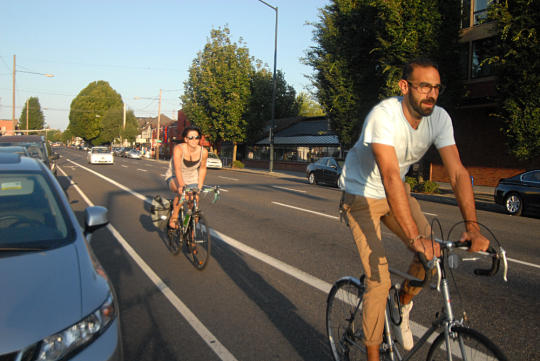
(Image by Owen Walz)
First in a week-long series about the BTA’s five new advocacy campaigns.
More than anything else in central Portland’s bike network, commercial corridors are the missing links.
Hawthorne, Belmont, Division, Mississippi, Alberta, Burnside, Fremont, NW 23rd, NE 28th: the neighborhood commercial districts that grew along Portland’s old streetcar lines have become the jewels in Portland’s crown — streets that make the city worth visiting, living in and caring about. They host a rapidly increasing share of local homes, and the businesses that line them — groceries, hardware, beer, music, shampoo — are the destinations for a huge share of the city’s trips.
But none of them has anything more comfortable to bike in than a door-zone bike lane, and many blocks have narrow, out-of-date sidewalks without much greenery.
This summer, the Bicycle Transportation Alliance has started a quiet campaign that is looking in an unexpected direction to create a better model: Northeast Broadway, from the Broadway Bridge all the way to Hollywood.
A call for better walking, too

(Photos: M.Andersen/BikePortland)
The BTA’s lead staffer on the campaign, advocate Carl Larson, said that though the BTA is trying to convene a conversation about how Broadway could be better and wants a high-quality bikeway like the one pictured above to be part of the conversation, it’s not wedded to a particular route or design.
Nor is a bikeway seen as the most important ingredient needed. Larson said what Broadway needs would be “part of a larger street treatment that improves, particularly, pedestrian movement up and down the street and across it.”
“We don’t have a set plan that we are trying to put in place,” Larson said. “We are truly trying to build consensus within the neighborhood and with businesses.”
To that end, BTA volunteer Chris DeLaney has been going door to door talking to businesses about what they want.
“Right now we’re hearing that crossing difficulty is a really serious concern and speeds are a real serious concern, and I’m pleasantly surprised to learn that lack of bike parking is a serious concern for many businesses on Broadway,” Larson said.
A route with potential

There’s no question that linking the dense, commercially rich Hollywood directly to the Rose Quarter area would be a huge boon for biking.
The roughly 2.5-mile route goes past numerous shops that households in the extremely bike-friendly neighborhoods nearby would, presumably, love to access by bike, but may not be because of the fast-moving traffic a foot or two away from the current bike lanes.
Larson said the best route might turn out to be along Broadway, Weidler or both. The exact eastern endpoint isn’t fixed, either.
But reducing the number of standard lanes on Broadway or Weidler in order to improve biking or walking access would make it much easier to cross the street and more pleasant to sit in a cafe alongside it, Larson said.
“By slowing down traffic it would make the businesses more visible,” he said.
Advertisement
A new model for advocacy
Sending a volunteer to gather business advice early in the process of planning a bikeway is something neither the BTA or the city has tried before.
The BTA hasn’t been shy about saying that the tactic was missing during the recent effort to redesign Northeast and Southeast 28th, which was scotched after a few businesses vehemently opposed to parking removal mobilized neighboring shops against the city’s plan.
“Business leadership has to be there if it’s going to work,” BTA Director Rob Sadowsky said in an interview. “It’d be nice if the city had the funding or the talent to do that.”
Larson referred to the work as “just patient relationship and consensus-building.”
“We see this type of work as necessary to pull off something like what the city wanted to do on 28th,” Larson said.
“I don’t know if this will be our job forever, to be cuing things up for the city,” he continued. “But right now, there is not a real commercial cycle track in this town. … Hopefully after we have that, a commercial cycle track will be easier to envision.”
Quick take: BikePortland’s summary of the project
Where the idea comes from: Basically from the BTA itself, but they’re hoping more detailed requests will emerge from businesses.
What it might cost: Several million dollars for the treatment pictured at top.
Likely tradeoffs: Narrowing and/or reducing the number of standard lanes.
Obstacles: Sadowsky said he thinks that a plan like this would require, at the least, the official endorsement of the local business association. There’s also the matter of communicating to more Portlanders that making all-ages biking possible on a commercial street is fundamentally different than making it possible on a neighborhood greenway. “Even people on bikes sort of lack the imagination to see what it would be like,” Larson said.
How you could help: Contact Larson: carl@btaoregon.org or (503) 226-0676 x16. “Right now we’re really looking for people who have a stake in what happens on Broadway, who are connected to Broadway businesses or the neighborhood and have some energy or creative ideas about how the street could be better,” Larson said.
Check back each day this week for another post in our series about new advocacy campaigns.



